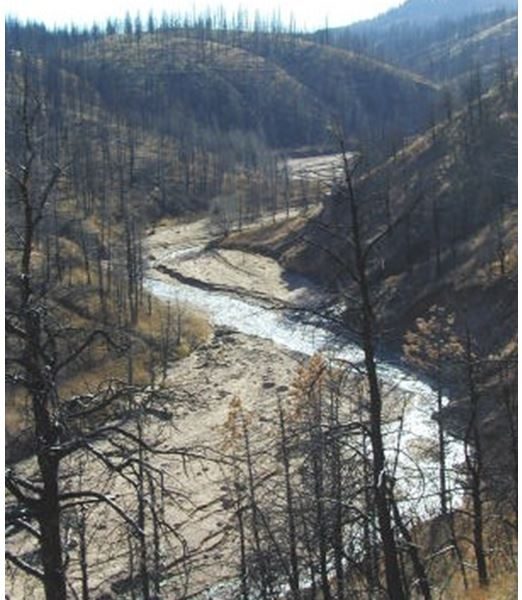
- Home
- Firm Profile
- Core Services
- Projects
- About US
- Contact Us
UPPER SOUTH PLATTE WATERSHED PROTECTION AND RESTORATION PROJECT
The Upper South Platte Watershed Protection and Restoration Project was initiated in August 1998 to address concerns regarding continued soil and water problems resulting from the 1996 Buffalo Creek fire and the potential for future fires to cause problems in other parts of the watershed. The goal was to develop a strategy for watershed restoration and protection. The project involves an interagency partnership between US Forest Service, Colorado State Forest Service, Denver Water Board, US Geological Survey, Natural Resources Conservation Service, and the Environmental Protection Agency. The partners adopted watershed restoration as a guideline for management and project planning.
Figures 1 and 2 show the photos of the burned sections of the Buffalo Creek watershed after 1996 fire.
The first step was to complete a landscape assessment that would identify and prioritize restoration opportunities to maintain and restore watershed functions. A primary goal was to find areas for forest restoration that could reduce the extent and intensity of events such as the Buffalo Creek fire and to strengthen the resilience of the most sensitive areas of the watershed if such events should occur.
The Landscape Assessment for the Upper South Platte Watershed that was completed in 1999 focused on identifying areas for restoration where forest conditions had deviated significantly from the historical composition. The ultimate goal of the Assessment recommendations was to move the forest toward a condition that will provide a more sustainable long-term model for the ecosystem with the constraints of the existing presence and use. One of the findings of the Landscape Assessment was that the soils in the Upper South Platte watershed are highly erodible when exposed to direct impacts of rain, sheetwash, rilling, or gullying. Hill-slope erosion following wildfire and high-rainfall events were stated to have been a major source of sediment to the drainage network.
The Environmental Assessment submitted in 2000 presented several types of activities and the environmental consequences of implementing these activities. In this study, the Environmental Assessment was critically reviewed and methodologies for carrying out sediment erosion computations from the Buffalo Creek watershed area were determined.
 Figure 1. Buffalo Creek watershed after 1996 fire.
Figure 1. Buffalo Creek watershed after 1996 fire. Figure 2. Buffalo Creek watershed after 1996 fire
Figure 2. Buffalo Creek watershed after 1996 fire Figure 3. Sediment erosion from burn areas in the watershed
Figure 3. Sediment erosion from burn areas in the watershed Figure 4. Sediment being transported down Buffalo Creek watershed during a major flooding event.
Figure 4. Sediment being transported down Buffalo Creek watershed during a major flooding event. Figure 5. Sediment deposition in the lower portions of the Buffalo Creek watershed in 2000
Figure 5. Sediment deposition in the lower portions of the Buffalo Creek watershed in 2000 Figure 6. Sediment deposition in the lower portions of the
Buffalo Creek watershed in 2000.
Figure 6. Sediment deposition in the lower portions of the
Buffalo Creek watershed in 2000.
 Figure 7. Tributary sediment outflow from the Buffalo Creek watershed in 2000.
Figure 7. Tributary sediment outflow from the Buffalo Creek watershed in 2000. Figure 8. Sediment deposition in the lower portions of the
Buffalo Creek watershed in 2000.
Figure 8. Sediment deposition in the lower portions of the
Buffalo Creek watershed in 2000.
